
Acrocercops leucocyma, also known as the kauri leafminer, is a species of moth in the family Gracillariidae. It is endemic to New Zealand.

Batrachedra psithyra, the spleenwort spore-eater, is a species of moth of the family Batrachedridae. It is endemic to New Zealand. This species has been observed in the North, South and Matiu / Somes Islands. This species inhabits overgrown grasslands or fern glades and have also been observed in gumland heath. The larvae of this species feed on fern sori including those on Histiopteris incisa. Adults are on the wing from November to January and tends to fly at sunset. At rest this species raises the front part of its body and when moving waves alternate antennae.
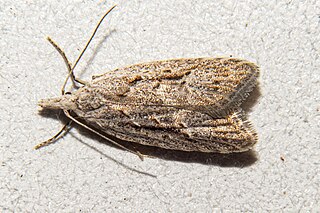
Heterocrossa cryodana is a species of moth in the family Carposinidae. It is endemic to New Zealand and is found in the southern parts of the South Island as well as at Codfish Island / Whenua Hou. This moth is associated with plants in the Leptospermum genus. Adults are on the wing from September until January.

Heterocrossa epomiana is a species moth in the family Carposinidae. It is endemic to New Zealand and has been observed in Westland. Adults are on the wing in January. This species is visually very similar to H. gonosemana and to H. philpotti.

Heterocrossa exochana is a species of moth in the family Carposinidae. It is endemic to New Zealand and has been observed in the North and South Islands. The larvae of this species feed on the fruits of Muehlenbeckia species. The adult is on the wing from September until May and are attracted to light.
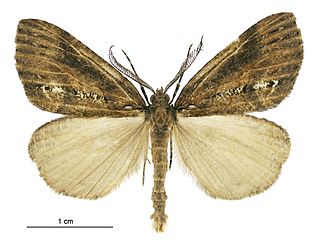
Chalastra ochrea is a moth of the family Geometridae. It is endemic to New Zealand. It has been observed in both the North and South Islands and inhabits native forest. Larvae of C. ochrea feed on the leaves of species in the genus Sophora including Sophora chathamica. Adults are on the wing from February until April. They have been collected via sugar traps.

Physetica prionistis is a moth of the family Noctuidae. It was described by Edward Meyrick in 1887. It is endemic to New Zealand and is widespread throughout the North, South and Chatham Islands. This species can be found in open clearings of shrubland and forest at altitudes from sea level up to the alpine zone. Adults are on the wing throughout the year and are attracted to sugar traps and occasionally to light. The life history of this species is unknown as are the larval host species.
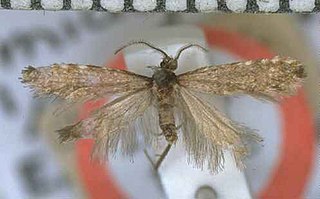
Reductoderces microphanes is a moth of the family Psychidae. This species is endemic to New Zealand. R. microphanes is a bagworm moth and its larvae likely feed on lichen or algae. Historically there has been some confusion over the identification of this species with George Hudson mistakenly describing and illustrating unnamed species and then attributing those descriptions and illustrations to this species. Charles Edwin Clarke discussed this species stating that it and its close relatives were active and able to be collected in damp mists before sunrise.

Charixena iridoxa, also known as the Astelia zig-zag moth, is a moth of the family Plutellidae. It was first described by Edward Meyrick in 1916. This species is endemic to New Zealand and has been observed in the North, South and Stewart Islands. The life cycle of this moth is at least two years in length with the larvae inhabiting the bulb of its host plants and mining the underside of its leaves. These mines have a distinctive zig-zag appearance and can be easily recognised when looked for on the host plants. The larvae pupate in a cocoon attached to the leaf and this stage takes place between February and August. The adult moths emerge in the early spring and are fast, day flying moths. Their larval hosts are plants in the genus Astelia and include Astelia fragrans and Astelia nervosa.

Eudonia aspidota is a moth in the family Crambidae. It is found in New Zealand and can be found in the North, South and Stewart Islands. The species inhabits native forest and its larvae lives on mosses.

Elachista eurychora is a species of moth in the family Elachistidae. This species is endemic to New Zealand and has only been collected at Paekākāriki. The habitat where the adult moth was originally collected was in rough vegetation on coastal sandhills or dunes but the collection locality has been significantly modified since that time. It has been hypothesised that the host of the larvae of this species is a grass. Adults are on the wing in March. It is classified as "Data Deficient" by the Department of Conservation.
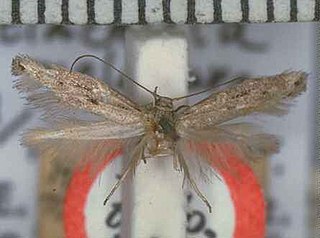
Elachista melanura is a species of moth in the family Elachistidae. This species is endemic to New Zealand. It is classified as "Data Deficient" by the Department of Conservation.

Pseudocoremia albafasciata, also known as the flash moth, is a species of moth in the family Geometridae. It is endemic to New Zealand. It is classified as Nationally Endangered by the Department of Conservation.

Erechthias acrodina is a species of moth in the family Tineidae. It was described by Edward Meyrick in 1912 using a specimen collected by George Vernon Hudson in Wellington. This species is endemic to New Zealand.

Erechthias crypsimima is a species of moth in the family Tineidae. It was described by Edward Meyrick in 1920 using a specimen collected by George Vernon Hudson in Wellington in February. This species is endemic to New Zealand. Hudson noted that he collected the type specimen of this species from the black trunk of a beech tree.
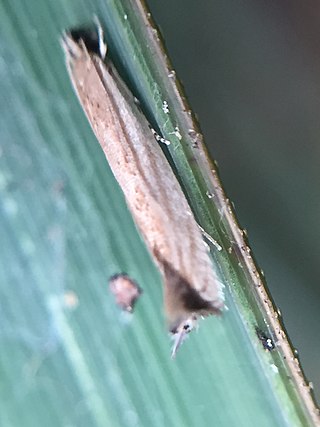
Erechthias exospila is a species of moth in the family Tineidae. It was described by Edward Meyrick in 1901 using a specimen he collected in Whangārei in December. This species is endemic to New Zealand.

Erechthias macrozyga is a species of moth in the family Tineidae. It was described by Edward Meyrick in 1916. This species is endemic to New Zealand. The holotype specimen of this species was collected at Tisbury, Invercargill by Alfred Philpott.

Eschatotypa derogatella is a species of moth in the family Tineidae. It was described by Francis Walker in 1863. This species is endemic to New Zealand.

Eschatotypa melichrysa is a species of moth in the family Tineidae. It was described by Edward Meyrick in 1880. This species is endemic to New Zealand. Meyrick regarded them as common in Wellington and Dunedin, in December and January. He obtained specimens from beating forest growth.

Notoreas atmogramma is a species of moth in the family Geometridae. This species is endemic to New Zealand. It is a day flying moth that frequents alpine habitat.




















